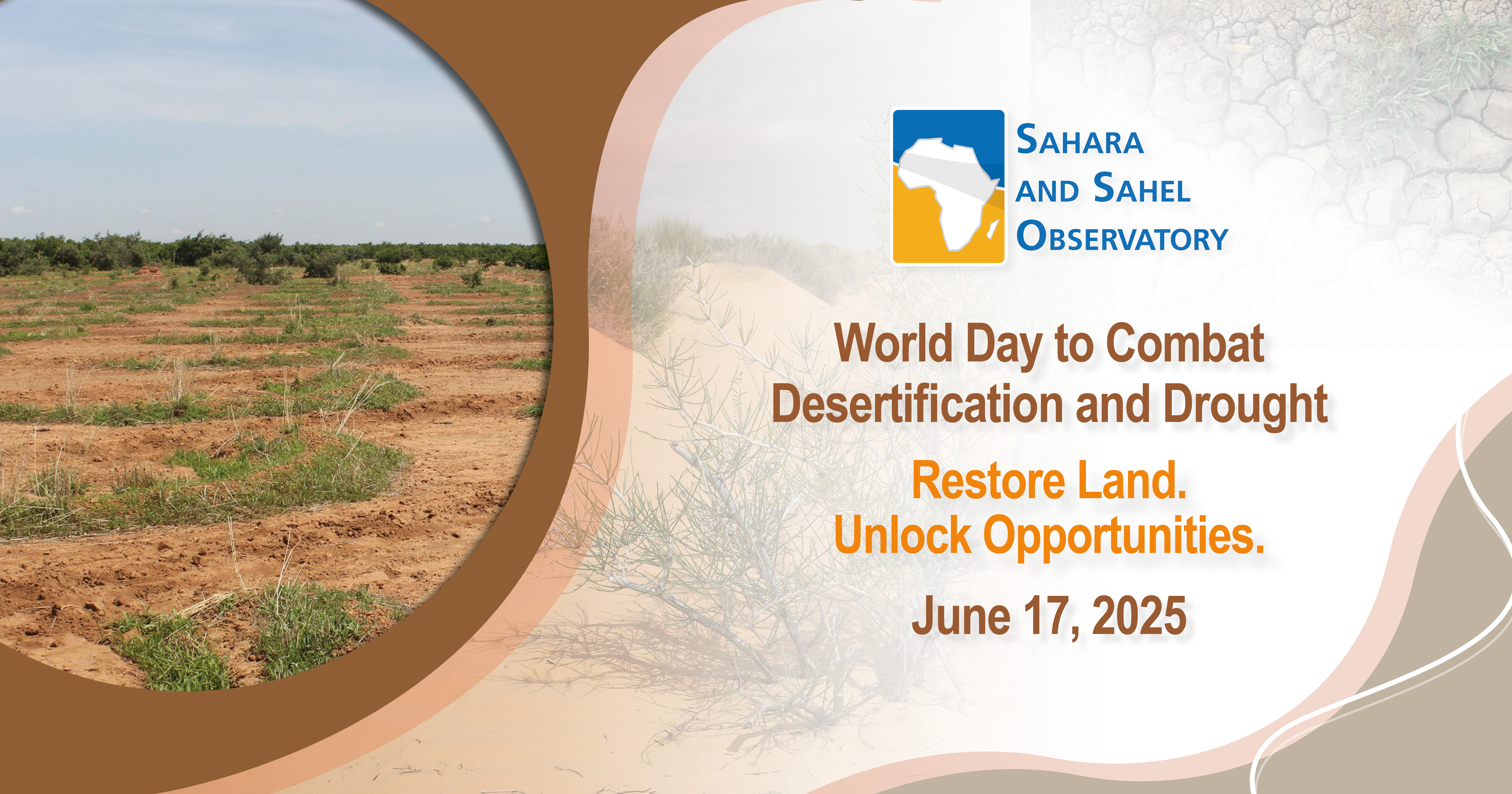Desertification and Drought Day 2025:
Restore the land. Unlock the opportunities

Mr Youssouf AMADOU
Project Management Officer
Sustainable Development Specialist,
Sahara and Sahel Observatory
It is June 17 and the world is turning to a silent, insidious, yet profoundly devastating scourge: desertification and drought. Behind these words, lands are being depleted, crops are dying, and communities are suffering. Through this World Day, the United Nations reminds us that land degradation is neither a far-looking nor abstract phenomenon, but a true reality that directly threatens food security, water resources, biodiversity, local economies, and, more broadly, social stability.
Every year, with the almost 100 million hectares of fertile land that disappear worldwide, we lose a promise of harvests, stability and life. According to the United Nations Convention to Combat Desertification (UNCCD), Africa finds itself at the front lines of this silent crisis and undergoes a rate of desertification nearly twice the global average.
Between 2020 and 2023, the prolonged drought that hit the Horn of Africa, particularly Ethiopia, Kenya, and Somalia, was absolutely devastating. Approximately 46 million people were directly affected by this crisis, including 13.5 million who were internally displaced, and more than 4.5 million who had to seek refuge abroad. The loss of livestock, a vital resource for pastoral communities in the region, is estimated at nearly 9.5 million head. This animal massacre stood behind economic losses of more than US$1.5 billion that add to the humanitarian, agricultural, and social costs, which remain difficult to quantify but further amplify the magnitude of the impacts that the region's vulnerable populations had to endure.
More broadly speaking, increasing aridification would have led to a 12% decline in African GDP between 1990 and 2015 and according to a WMO report, published in 2024, Africa “loses on average 2% to 5% of its GDP each year” due to climate hazards. Without immediate measures, the continent's agricultural production could fall by 17 to 22% by 2050, exacerbating food insecurity, rural poverty, and conflicts over access to land and water. Yet Africa also remains a continent of hope, driven by traditional knowledge, a strong local dynamic for land restoration, and the growing commitment of its youth to building a sustainable and resilient future.
Frameworks are in place, action is fragmented
Despite the growing urgency of the situation, international efforts to halt desertification remain fragmented, underfunded, and even overshadowed. The three Rio Conventions, adopted in 1992 to address the interconnected crises of climate change, biodiversity loss, and land degradation, keep operating behind sealed doors, each with its own timeline, strategic priorities, and specific financing mechanisms. This partitioned governance truly limits any integrated dynamic and significantly reduces the impact of interventions, both at the international and national levels.
In many countries, particularly in Africa, focal points of the three conventions still operate each on its own, in an attempt to fulfill its obligations with human, technical, and financial resources that are not only insufficient but often unevenly distributed. This lack of coordination weakens the ability of the States to find to adequate responses and compromises their possibilities to address these closely related challenges.
The imbalance is particularly astonishing with regard to the United Nations Convention to Combat Desertification, too often perceived as the Cinderella area of the Rio Conventions. Driven by an annual conference that attracts global attention, the Climate Convention is politically and financially supported, while those on biodiversity and desertification meet only every two years and pass almost unnoticed. Such an inequitable treatment contributes to marginalizing the fight against land degradation, even though it is at the heart of other ecological crises: climate, biodiversity, food security, access to water, and social stability.
At a time when the planet is approaching critical thresholds, the global environmental agenda can no longer overlook land degradation.
Isn’t it time for a unified sustainability governance?
Given the scale of the challenges and the failure of siloed approaches, far-reaching and structural reforms are essential. At the international level, it is time for a fundamental rethink of global environmental governance. Holding a single, integrated Conference of the Parties (COP), bringing together climate, biodiversity, and desertification, seems to be a strategic necessity. Such convergence would build a common front, mobilize resources more effectively, strengthen synergies, and, above all, restore balance between the three pillars of sustainable development. It would put an end to the persistent invisibility of the fight against land degradation, while reducing the costs, administrative duplication, and carbon footprint associated with multiple participations in multiple forums.
At the national level, sectoral strategies that undermine the impact of actions have no reason to ever be considered. Developing unified strategic frameworks, integrating Nationally Determined Contributions (NDCs), Biodiversity Action Plans (NBSAPs), and National Action Programs (NAPs) on desertification, is essential as a consistent and pragmatic approach. Panama, host of the next Committee for the Review of the Implementation of the UNCCD (CRIC 2025) and one of the many countries that understood the importance of such an approach, is leading the way by developing a single framework bringing together the commitments of the three Rio conventions. Africa must jump on board and adopt these integrated approaches to build environmental policies that are clearer, more effective, and better meet the realities of its territories.
Co-constructing policies as closely as possible to realities
The effectiveness of policies to combat desertification and drought cannot be measured solely by the existence of strategic frameworks or the mobilization of international funding. It depends, above all, on the ability of countries to establish sustainable, inclusive spaces for dialogue that are rooted in local realities. Without national and local ownership, strategies are close to a dead person who produces no result whatsoever.
This is the very ambition of the national multisectoral platforms promoted by the OSS as part of its support to African countries. These platforms bring together stakeholders from the three Rio Conventions (climate, land, biodiversity): technical ministries, specialized agencies, research centers, local authorities, and civil society Organizations. Playing a strategic role at several levels, they contribute to the definition of national targets for Land Degradation Neutrality (LDN), climate change adaptation, and biodiversity preservation. They also ensure the preparation of national reports for the conventions, drawing on consolidated, validated data shared between the relevant institutions.
Beyond their technical role, these platforms are becoming genuine hubs for political and social innovation. They promote bottom-up governance, strengthen citizen participation, and contribute to the emergence of more democratic, effective, and accountable environmental governance. Supporting and institutionalizing these national platforms is investing in the foundations of resilient, legitimate environmental governance capable of addressing the complex challenges of tomorrow.
The OSS also supports civil society Organizations in their advocacy and awareness-raising efforts among communities and local populations, who are often on the front line in the fight against land degradation. Here is exactly how the Désertif’Actions initiative, an international forum dedicated to CSOs active in drylands, is taking shape. The 2026 edition, due on March in Djerba, Tunisia, will provide a major platform to amplify the voice of non-state actors, showcase their field experiences, and strengthen their contribution to the global land restoration agenda.
True to its missions, the OSS has remained at the forefront of desertification-driven endeavors. As part of its recent actions, it produced in 2024 a map of land degradation in Africa (SDG indicator 15.3.1), widely analyzed and commented on in the documentary book: African Land: The degradation and the Absolute Requirement of Sustainable Management. In addition, several platforms and geo-servers integrating data and satellite imagery have been developed by the OSS to support decision-making of its member countries in their fight against land degradation. Among these tools, the Misland platform stands out for its performance and relevance.
On this Desertification and Drought Day 2025, Africa reminds the world that it is not only a continent of crises, it is also a continent of proposals, rich in initiatives, resilience, and solutions. Restoring its land means reconciling social justice, economic prosperity, and ecological sustainability. The opportunities are there. It is time to seize them, with determination.
